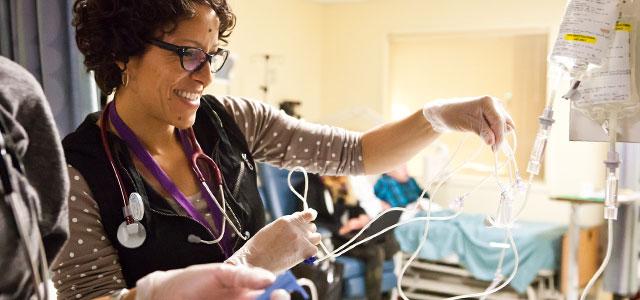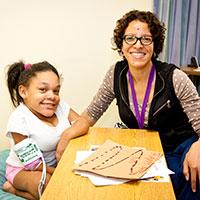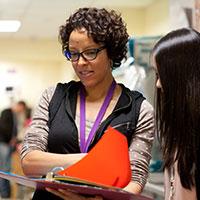
Ebony Parker at Children’s Hospital Oakland (photos by Elisabeth Fall)
What Preceptors Do: Ebony Parker Gives MEPN Students Hands-On Experience in Pediatrics
Volunteer clinical faculty and preceptors offer students individual perspectives and hands-on experience in a variety of health care settings and specialties. The cumulative effect of what these volunteers impart plays a significant role in the care any health system delivers. This series aims to shed light on the unique roles these valuable mentors play.
This month, we hear from Ebony Parker, an acute care pediatric nurse and clinical instructor in the School of Nursing’s Master’s Entry Program in Nursing (MEPN).
I was a social worker in my first life. Like all of the students I work with in the MEPN program, I’m a second-degree newcomer to nursing. I went to school as an undergrad in Los Angeles and studied sociology and psychology; I liked the idea of thinking about thinking, and deconstructing that which we see. I did a master’s program in social welfare because it was oriented toward addressing systemic issues that affect individual and social well-being, and that interested me.
After I finished my master’s, I worked for an education-focused nonprofit that supported kids identified as successful academically and socially, but who didn’t have the financial resources or the legacy of achievement that would get them to college. They were admitted to the program in seventh grade and matched with adult mentors who kept them involved with the program activities and formed connections with their families. It was a wonderful thing to do as an early-20-something with a lot of idealism.
 When I moved to Texas, I continued working with teenagers in school-based nonprofit programs that were primarily aimed at using evidence-based curricula in drug prevention. I worked in a high school, a juvenile detention facility and a transitional housing facility, implementing a state-mandated curriculum. It was a good change from Los Angeles and its private nonprofit world because I gained entrée into many different settings that I wouldn’t otherwise have had access to.
When I moved to Texas, I continued working with teenagers in school-based nonprofit programs that were primarily aimed at using evidence-based curricula in drug prevention. I worked in a high school, a juvenile detention facility and a transitional housing facility, implementing a state-mandated curriculum. It was a good change from Los Angeles and its private nonprofit world because I gained entrée into many different settings that I wouldn’t otherwise have had access to.
I thought about nursing school in college, but I don’t think I was ready to work on the hard sciences at that time. In Texas I was able to take some nursing prerequisites and then was admitted to an accelerated BSN program in Florida. All students had the option of advancing through the master’s degree, but I elected not to so that I could instead start a bedside nursing practice and gather as much inpatient experience as possible.
My original intention was to go into adult oncology, but when I returned to California, there was a job opening in pediatric acute care at Children’s Hospital Oakland, so that’s where I went. I’ve since worked at Lucile Packard Children’s Hospital at Stanford, UCSF Benioff Children’s Hospital and Kaiser San Francisco, which is where I work now, in a 10-bed acute care unit. I’ve been in pediatric acute care since 2006, and now I can’t imagine not being a pediatric nurse.
I’m also working on a research study at Children’s Hospital Oakland Research Institute, investigating a new drug for a rare genetic anomaly that causes musculoskeletal, neuromuscular and connective tissue problems in children. I administer the drug and monitor patients for reactions once a week, with children coming in from all over the country to participate. Most importantly in this work, I’ve formed some great relationships with our patients and families.
I became an instructor when a friend gave my name to two UCSF School of Nursing professors who were working in pediatric and family health care nursing. They needed another clinical instructor for the MEPN program, and in January 2011, I worked with my first students. I found that becoming the best teacher I could be was really important to me, so I eventually opted out of full-time nursing to focus on being a clinical instructor.
Nursing school today provides a lot of didactic classroom work, and it’s my job to help translate that intellectual knowledge into bedside skills. When I’m with my students in their hospital rotations, I try to identify as many hands-on learning opportunities as I can. As a clinical instructor, I can sit down and spend 45 minutes with the students breaking down a 5-minute task, which a bedside nurse carrying a four-patient assignment doesn’t have the time for. I use a matrix to make sure that every one of my students has an opportunity to be exposed to certain things, but we’re limited by the fact that the rotation is only six weeks long.
 Having been a second-degree nursing student, I think I understand some of the pressures facing the MEPN students. There’s a feeling that you must be completely independently prepared, with enough experience between school training and critical thinking that you’ll be able to do everything, answer every question correctly. But that’s not realistic. You can’t expect to go from no knowledge on day one to knowing everything after only a dozen 8- to 12-hour days in a pediatric acute care unit. I try to normalize that for the students and relieve some of their anxiety.
Having been a second-degree nursing student, I think I understand some of the pressures facing the MEPN students. There’s a feeling that you must be completely independently prepared, with enough experience between school training and critical thinking that you’ll be able to do everything, answer every question correctly. But that’s not realistic. You can’t expect to go from no knowledge on day one to knowing everything after only a dozen 8- to 12-hour days in a pediatric acute care unit. I try to normalize that for the students and relieve some of their anxiety.
At the end of the semester, the students do a day in the simulation lab, and I facilitate ethics discussions for them as they’re rotating in and out of the lab. I really enjoy being able to see different perspectives and drawing new things out of my interactions with them. I wholeheartedly believe that I gain so much more from teaching my students than they do learning from me.



